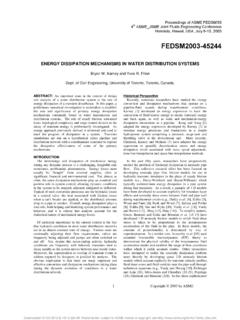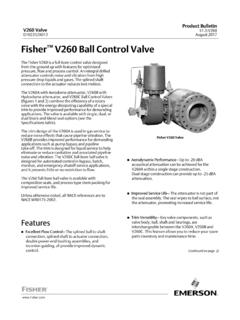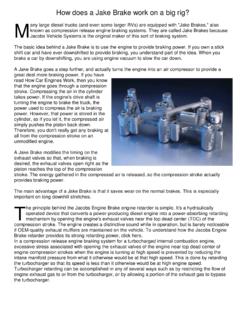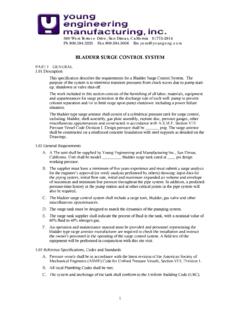Transcription of Homogenizer Handbook - APV Hemisan
1 Homogenizer HandbookProcessing of Emulsions and Dispersions2 From its very genesis APV has maintained an impeccable reputation for excellence worldwide. That standard is perpetuated in the field of homogenization and high pressure pumps. It s a tradition that dates back to our invention of the Homogenizer in the early 1900 s. That desire to excel in saving our customers is demonstrated today through innovative design, precision, engineering, quality manufacturing and attention to detail within the APV Homogenization Division. This division, created by the unifying of APV Gaulin and APV Rannie introduced a new era in the industry.
2 With more than 155 years of combined experience, APV provides our customers with the greatest resource for homogenization technology ever assembled. While maintaining the distinguishing characteristics and unique designs of the GAULIN and RANNIE products, APV is now able to offer a much greater range of equipment and service from a single source. The APV Homogenizer group is ready to meet the challenges facing us in this exciting, technologically advanced world, and we look forward to serving you!World Leader in Homogenization Technology3 IntroductionThe APV Homogenizer Group designs and manufactures high-pressure homogenizers (operating pressures up to 29,000 psi/2000 bar) for the processing of emulsions and dispersions.
3 Emulsions with viscosities up to several thousand centipoises, cP, (for the premix) may be processed, and a particle size as small as micrometers is possible by selecting the correct unit. The same viscosity and particle size limitations apply in the case of dispersions. Naturally, there will be some overlapping as to viscosity and particle size governing the choice of equipment; but, in general, the operating parameters are sufficiently well defined that an intelligent choice for evaluations may be made. Emulsions and dispersions encompass a significant number of products that would seem to be, on cursory examination, totally unrelated to each other in form, substance and method of production.
4 However, a more detailed investigation would reveal that many basic elements are common to all emulsions and dispersions. To discuss the topics of homogenization and emulsification in a reasonable space, it is necessary to relate these processes to the basic elements of emulsions and dispersions. Therefore, although this Handbook will examine general conditions of homogenization, it is reasonable to expect that most emulsions and dispersions will respond in similar ways to these processing techniques. HomogenizationAt the World s Fair in Paris in 1900, Auguste Gaulin exhibited his a process for treating milk.
5 According to the literature and publications of that time, the word homogenized was first used to describe milk treated by the Gaulin machine. Therefore, the terms homogenization and Homogenizer historically relate to the process and equipment developed by Gaulin. The Homogenizer basically consists of a positive-displacement pump to which is attached a homogenizing valve assembly. The pump forces fluids through the homogenizing valve under pressure. (This is described in more detail later in the Handbook .) The term homogenization refers to the process or action that occurs within the homogenizing valve assembly.
6 Today, the terms homogenization and Homogenizer are quite often incorrectly applied to devices that subject a liquid mixture to conditions different from that in the Gaulin and Rannie homogenizers . In this Handbook , homogenization and Homogenizer refer to the action and equipment related to the classically recognized Homogenizer . 4 HomogenizersTo understand how the Homogenizer works and what it does, it is first necessary to trace the path of the liquid mixture through the homogenizing valve. Figure 1 shows a plug-type homogenizing valve and standard valve seat. The unhomogenized product enters the valve seat from the pump cylinder at a relatively low velocity but at a high pressure.
7 For example, the velocity may be about 10 to 20 feet per second ( to m per second). The pressure for this example will be at 3000 psi ( bar). This pressure is generated by the positive-displacement pump and by the restriction to flow caused by the valve being forced against the seat by an actuating force. The positive-displacement pump provides a relatively constant rate of flow and, therefore, will generate the required pressures as the flow area between the valve and seat is increased or decreased. The liquid flows between the valve and seat at high velocity. In this case at 3000 psi the corresponding velocity would be about 500 feet per second ( m per second).
8 As the velocity increases, the pressure decreases producing an instantaneous pressure drop. The liquid then impinges on the wear ring (impact ring) and is finally discharged as homogenized product. The time it takes for the liquid to travel across the face of the valve seat and to undergo homogenization is less than 50 microseconds (5 one hundred thousandth of a second). Therefore, it can be seen that a large amount of energy is dissipated in a very short time, producing a large energy density in the liquid. Figure 1 How the Homogenizing Valve WorksBasic ProductValveSeatHomogenized ProductValveImpact Ring5 The theories of homogenization that have been presented over the years have attempted to relate this high-energy transition in the valve to the results observed in the product.
9 In the past, it was difficult to prove or disprove many of these theories, but it appears that turbulence is the primary , something should be said about shear in the valve, because many people assume that shear is the main mechanism of homogenization. When using the term shear , one is describing the elongation and subsequent breakup of a dispersed phase droplet because of different fluid velocities surrounding the droplet. The classical theories of shear effects, as related to the flow profile in the homogenizing valve, are difficult to justify. Two arguments against shear are (1) the viscosity of many fats and oils is greater than the maximum value allowed for shearing of the droplets, and (2) the flow profile in the valve is such that the bulk of the liquid does not experience large velocity gradients due to the boundary layer effects.
10 In the cavitation theory, the liquid encounters intense cavitation because of the large pressure drop through the valve. When the pressure drop is large enough, the vapor pressure of the liquid exceeds the ambient pressure causing formation of vapor bubbles (cavities in the liquid). When the cavitation bubbles implode (collapse of the cavities), shock waves are generated in the liquid. These shock waves break apart the dispersed droplets. The second homogenization theory, relating to turbulence, suggests that the energy dissipating in the liquid generates intense turbulent eddies. These eddies would be of the same size as the average droplet diameter.






